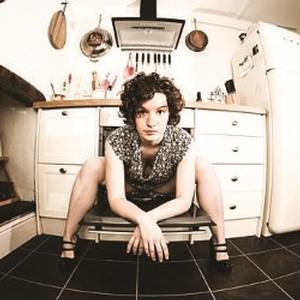As we enter the space, a woman is standing on the empty stage. She’s fairly young, tall, slim, pale skinned, auburn haired, attractive in an understated way. Dressed in a short floral dress, bare-legged, no obvious make-up. If we had to be more specific, we’d say that she looks like a typical educated, personable young woman from the English middle classes. She looks out at us, returning the gaze. This is me, her posture seems to say. Just me – here I am. As the doors close, the recorded voice-over starts: ‘I’ve never told anyone this story…’
It purports to be a love story, although always with the edge that something is going to happen – it’s clearly not going to end in happily-ever-after. There’s a section of movement work that follows the words about meeting, first date, and falling in love unexpectedly. Soft, sensuous, flowing – reflecting the words. This is the pattern set up: text, then movement in response – a kind of call and response. There are also words spoken live – dancer/choreographer Zosia Jo’s own writings, adding a poetic element to the more prosaic voice-over text
The affair progresses, and the movement changes to something more earthy and robust. She has, says the recorded voice ‘a proximity crush’ and she waxes lyrical on his tight torso, glimpsed as he pulls up his T-shirt a little, absentmindedly. She moves down to floor level and stands, again and again. ‘I guess this is why they call it falling’.
There is also (recorded, but original compositions) music: Ry Cooder-style slide guitar – for a moment, evoking Wim Wenders’ Paris Texas. Whether deliberate or accidental, this is a nice touch. This shifts into full-on raunchy rock, as we learn that the object of our character’s desire is the frontman in a band. Standing at the front, gazing at hm adoringly, she turns around and sees that she is not the only one. The room is full of adoring female eyes. Doubts creep in, and there are a number of alarm bells ringing. ‘A text can change your life’ is said more than once. We start to construct narrative, to guess where this is going.
The piece seems, for a while, to be stuck in a bit of a groove, with the structure of movement illustrating the text progressing. But just when I start to feel a little bored, wondering why I’m being told this everyday story of a normal, youthful relationship with its ups and downs and ins and outs, it changes. There’s a punchline, and it comes as the shock it is intended to be.
The show ends as it begins, with the performer standing calm and upright in the space, watching us – although the story we have heard has changed the relationship we have with her.
It is a story of love going badly wrong that is, sadly, timeless. It is a story that the creator describes as ‘both true and untrue’. The recorded text is based on verbatim interviews with a number of women about their relationships with men. I find the structure of the piece a little formulaic, and feel that there could be more development (in this or in future work) and exploration of how text and movement can interact in a more challenging, less illustrative, way.
But this is an important story that needs to be told, and although the show has flaws, it is good to see dance employed in the telling of important verbatim stories.

